Alfalfa continues to be a world-class leader for feed value for North American production agriculture. This is especially true for the areas in the Intermountain West. While acre numbers are not at historical highs, they are still high enough to be the largest cropping acres in most Western states. Forages including alfalfa are enjoying some of the greatest economic returns that have been observed for many years. A lot of this is related to changes in population in these areas.
There continues to be growth in dairy markets, with larger and larger dairy operations looking for high-quality feed for milk production as well as feed for livestock in feedyards. All of these contributing factors have pushed the price of alfalfa well beyond expectations from just a few years ago.
These changes are bound to get producers’ attention and ask the questions regarding strategies for increasing production. Farm managers continue to have an interest in developing a better understanding of how to improve nutrient-use efficiency with timing applications of fertilizers including low-salt nitrogen, phosphorus and potassium (NPK) liquids. This is true for the farm management team at Simplot Land and Livestock (Grand View, Idaho, the second-largest cow-calf operation in North America), where these studies were conducted.
Yield of all crops, including alfalfa, will always be dependent on amount and quality of irrigation water in the desert areas of this geography; however, proper nutrition related to available fertility becomes of primary importance. This is especially true for P fertilizer use as growers push for high yields and high feed value, but also being conscientious of environmental constraints. “Phosphorus is the most common fertilizer input for alfalfa across the western U.S. It is essential for optimum alfalfa production and quality but may also create concerns for the environment,” said Dr. Glenn Shewmaker, former extension forage specialist and professor at the University of Idaho.
Potassium is also a nutrient heavily used by rapid-growing alfalfa and, in many growing conditions, needs to be managed similar to P fertilizer. In the authors’ experience, if P and K are both limiting, the need is to first apply phosphorus and resolve that as a limiting nutrient, and secondly apply potassium. In many production fields, although P and K may test adequate in the soil, there may very well be other factors that limit the ability to access these primary nutrients in a timely manner to maximize yield and improve alfalfa quality.
These studies explore the potential of making in-season applications of low-salt liquid NPK fertilizer on alfalfa between cuttings to promote the production of high-yielding and high-quality forage. Many times, growers and researchers only focus on dosage or rate of nutrients applied when other parts of nutrient management criteria should also be explored. This study addresses both timing and form of nutrient delivery as part of the “4 R” nutrient stewardship process.
Foliar applications of low-salt NPK fertilizers were applied to established irrigated alfalfa during the 2012 and 2013 growing seasons. In 2012, applications were made when the regrowth was about 6 to 8 inches tall following the first and second cuttings. These applications were made with a commercial high-clearance sprayer. The NPK liquid applications (3-18-18) were applied to 6-acre plots (replication = 2) at zero, 2.5 or 5 gallons of 3-18-18 per acre. Irrigation was delayed for 24 hours following application to ensure adequate drying on the alfalfa foliage.
Applications of foliar nutrients applied in-season increased yields during the 2012 season for each of the cuttings (Figure 1).
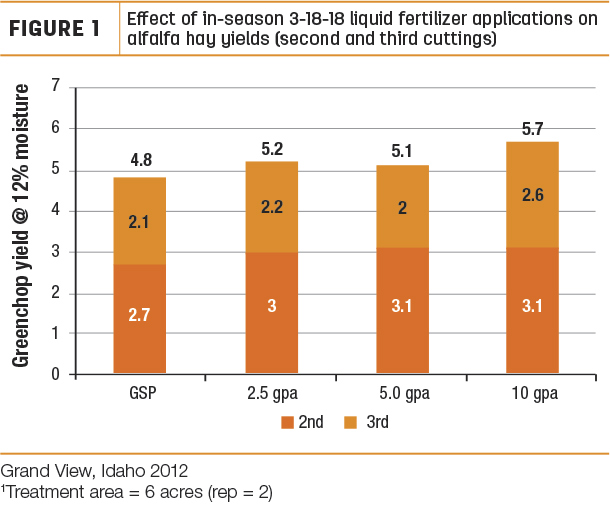
These yield improvements were able to deliver an economic improvement for the forage production. Kent Frisch, Simplot farm manager, said, “It looks like these applications are something we should be pursuing. However, the system needs changing for ease of applications.” Therefore, changes were made the following year to address the farm’s concerns.
In 2013, three adjacent 120-acre pivots of the same variety and age of alfalfa were selected for evaluation. Three treatments were used:
1. 3-18-18 applied by aircraft
2. Fertigated through the center pivot were compared
3. Grower standard practice (GSP) where no additional nutrients were applied
Liquid NPKs were applied when the crop had a regrowth of 6 to 8 inches. Application rates were 3, 5 and 5 gallons per acre for the first, second and third cuttings, respectively.
Each pivot (114-acre harvest area) was harvested with commercial swathers with each truck weighed with hay quality samples removed for quality analysis. In all, there were about 600 trucks weighed and sampled, providing a very good evaluation of treatment responses. Forage quality samples were collected for NPK concentration and forage quality analysis at an independent lab. The main objective of the Simplot alfalfa is for livestock feed, and it was all greenchopped and converted to 65% moisture; alfalfa hay yields were converted to 12% moisture (Figure 2).
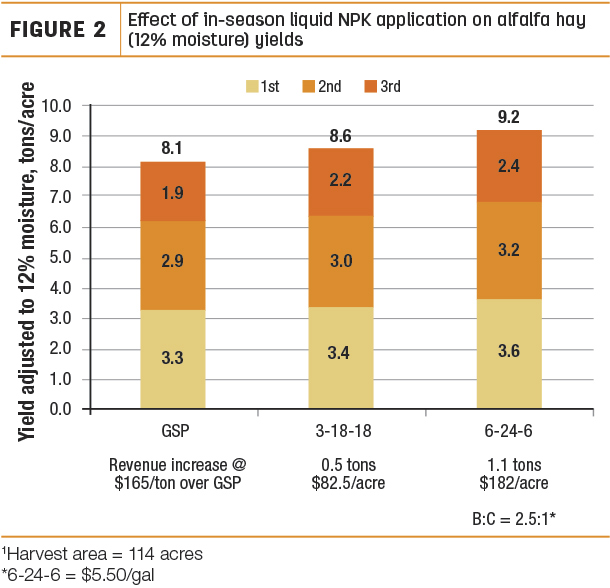
Yield improvements were positive for both the 3-18-18 and the 6-24-6 applications. However, the applications applied through the center pivot were higher. Improvements of yields were impressive with 6-24-6 providing a 3-ton-per-acre (at 65% moisture) improvement over the grower standard practice of 20.5 tons per acre.
Converted to a 12% moisture, alfalfa hay yield resulted in a 1.1-ton-per-acre yield increase. Assuming the value of high-quality alfalfa hay at $165 per ton, the benefit-to-cost ratio for the 6-24-6 application (retail cost approximately $5.50 per gallon) results in a 2.5-to-1 benefit-to-cost ratio, meaning that for every $1 spent on the product, there was a $2.50 return to the farm. Improvements with these types of applications for both years have encouraged the cooperating farm managers to incorporate these applications into many of their alfalfa fields for the future.
“If we can consistently see these types of responses, and the materials can improve our alfalfa production benefits to costs by at least a 2 to 1, our alfalfa production will be seeing more of these applications,” Clements said.
The 2013 trial indicated a very positive response to in-season NPK applications. Improvements in nutrient content of P and K were both remarkable (Figure 3 and Figure 4).
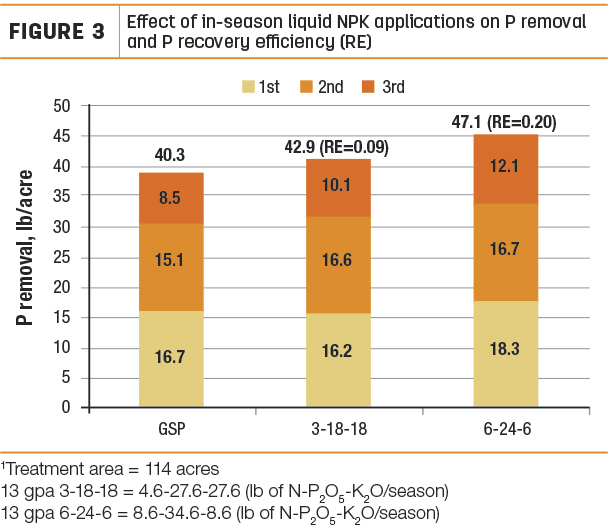
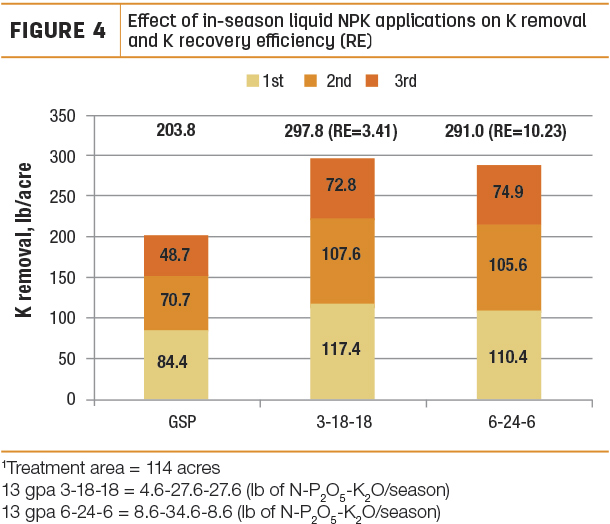
It is interesting to note the increase in tissue concentration and removal from relatively low applications for both P and K. Recovery efficiency (RE) of nutrients provides an estimation of efficient nutrients utilized by the crop (calculated as the total nutrient removal with fertilizer minus total nutrient removal without additional fertilizer, divided by the amount of the fertilizer applied). As much as three times K removal and two times the P removal was observed for the 6-24-6 versus the 3-18-18, indicating the 6-24-6 was a more efficient application on the alfalfa.
The J.R. Simplot Company continues to improve on nutrient management as it applies to both new products as well as to gain a better understanding of how to use the nutrients we have. There was an improvement in relative forage quality, and it could be attributed directly to increased nutrient uptake as a result of these in-season low-salt NPK fluid fertilizers being applied.
It should also be noted that improvements in relative feed quality (RFQ) were also positively influenced – and especially with the 3-18-18 applications (Figure 5).
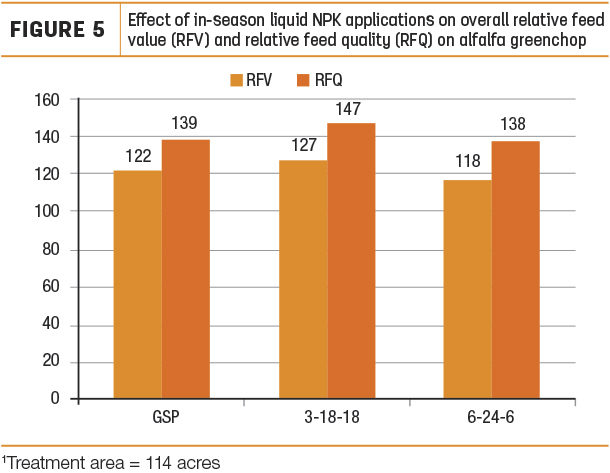
This may have been related to the higher concentration of tissue K that resulted from this particular NPK low-salt foliar application. The positive nature of improvements to alfalfa production with in-season applications of NPK liquids is a great example of addressing the current needs for growers and crop advisers.
It should be noted that because of this very involved set of data conducted on these large fields and the positive measurable responses (to meet the 2-to-1 economic returns) that almost 8,000 acres of alfalfa being irrigated by center pivot are currently receiving similar in-season applications of 6-24-6 being injected through pivots on the farm.
The authors wish to acknowledge the Simplot Grand View farm management team for their support of this extensive on-farm research project.









